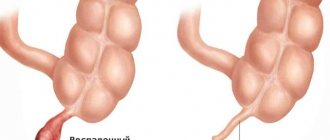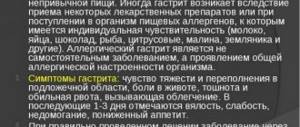Appendicitis is an inflammatory process in the appendix, accompanied by varying degrees of discomfort. Most diagnosed pathologies occur in an acute form. Is there such a thing as chronic appendicitis? The problem is usually faced by young women. With constant relief of abdominal pain by any means other than surgical treatment, a rare pathology can develop - chronic appendicitis. Men and women with a similar diagnosis should be constantly monitored by a specialist.
Forms of the disease
There are three forms of chronic appendicitis:
- residual (residual) form - develops after a previous acute appendicitis, which ended in recovery without surgical intervention;
- primary chronic form - develops slowly, without a previous attack of acute appendicitis. Some experts question its presence, so the diagnosis of primary chronic appendicitis is made only after excluding the presence of any other pathology that can cause a similar clinical picture;
- relapsing form - characterized by recurrent symptoms of acute appendicitis in the patient, which subside after the disease goes into remission.
At any time, chronic appendicitis can turn into an acute form, and untimely surgical operation in this case threatens the development of peritonitis, a potentially life-threatening condition.
Carrying out diagnostics
Only after a thorough diagnosis will a specialist make the correct diagnosis.
A doctor can determine the cause of the disease and make a diagnosis only after conducting a thorough diagnosis. The specialist collects information about signs of the disease, complaints, performs palpation and prescribes the necessary tests:
- ultrasonography;
- general blood and urine analysis;
- computed tomography;
- irrigoscopy;
- colonoscopy;
- diagnostic laparoscopy, etc.
In addition, it is necessary to carry out differential diagnosis with:
- cystitis;
- Crohn's disease;
- vaginitis;
- peptic ulcer, etc.
Causes and risk factors
The main reason for the development of chronic appendicitis is a slow-moving infectious inflammatory process in the appendix.
The development of primary chronic inflammation is facilitated by disturbances in the trophism and innervation of the appendix wall, which lead to a decrease in local immunity. As a result, microorganisms contained in the intestines provoke mild inflammation, which can last for many years, causing discomfort and pain in the right side of the abdomen. Under unfavorable conditions, a sluggish inflammatory process can be sharply activated, and then acute appendicitis develops.
The main cause of chronic appendicitis is a sluggish infectious process
Secondary chronic inflammation is the outcome of acute inflammation of the appendix. If, for one reason or another, surgical treatment of acute appendicitis has not been performed, very dense adhesions form in the appendix, reducing its lumen. This causes stagnation of intestinal contents in the appendix, which provokes a long-term inflammatory process of insignificant activity.
The recurrent form of chronic appendicitis can be caused by both primary and secondary chronic inflammation. Periods of exacerbation of the disease are provoked by various unfavorable factors (stress, hypothermia, acute infectious diseases), which reduce general immunity and thereby create the preconditions for increased activity of the inflammatory process in the appendix.
Recurrent chronic appendicitis in very rare cases develops after surgical removal of the appendix (appendectomy). This can happen if the surgeon left a portion of the appendix longer than 2 cm.
Complications
There are several possible complications of a dangerous process. The most common are:
- formation of adhesions in the appendix;
- development of appendicular infiltrate (tissues changed by the inflammatory process);
- abscess of appendicular infiltrate.
Depending on the type of complication, conservative treatment of chronic appendicitis or surgical intervention is performed.
Chronic appendicitis is a pathology that is rare and difficult to diagnose, requiring differentiation from many diseases with similar symptoms. Timely removal of the appendix is the key to successful recovery from disturbing symptoms and does not affect the quality of life.
Symptoms of chronic appendicitis
The symptoms of chronic appendicitis are blurred, and sometimes may be completely absent (during periods of remission in the recurrent form). Typically, patients complain of periodically occurring aching dull pain in the right iliac region. The pain is of low intensity, but can intensify under the influence of gross errors in diet or intense physical activity.
The main symptom of chronic appendicitis is dull aching pain in the iliac region
Other symptoms of chronic appendicitis are:
- flatulence;
- constipation alternating with diarrhea;
- nausea;
- increase in body temperature in the evening to subfebrile values (37.1 – 37.9 °C).
In women, a symptom of chronic appendicitis is pain that occurs during mechanical action in the area of the uterine body, for example, during sexual intercourse or a gynecological examination using a vaginal speculum.
Pain that occurs during a rectal examination of the prostate gland may be a symptom of chronic appendicitis in men.
Chronic appendicitis may also be accompanied by the development of bladder manifestations - frequent and painful urination.
With exacerbation of chronic appendicitis, patients develop a clinical picture corresponding to acute appendicitis.
Symptoms and classification of the disease
The chronic form of the disease is characterized by weak, unstable symptoms, which makes diagnosis difficult. Patients often complain of the following signs of chronic appendicitis:
- pain in the navel or iliac region;
- constipation or diarrhea;
- feeling of heaviness in the lower right abdomen, discomfort;
- frequent urge to urinate and painful process;
- painful sexual intercourse and gynecological examination;
- pain in the rectum, increasing during examination;
- exacerbation of the pathology is accompanied by nausea and vomiting.
The patient feels increased pain during tension in the abdominal region - during physical activity, sneezing, laughing, coughing, defecation. The pain may radiate to the groin area, lumbar region, or right thigh.
The patient's general health is stable: there is no feeling of weakness or fatigue. Body temperature is normal, in rare cases there is a slight increase in the evening. This picture may persist for several years and not particularly bother the patient. But the risk of developing into an acute form always exists.
With an exacerbation of chronic appendicitis, symptoms similar to acute appendicitis will appear: severe pain in the abdominal cavity, high fever, nausea, dry mouth and white coating on the tongue.
Classifying chronic appendicitis, the following types are distinguished:
- Primary chronic – is a low-grade inflammatory process without exacerbations or pronounced symptoms. Diagnosis is difficult; it is carried out on the basis of tests by excluding other pathologies with similar symptoms.
- Secondary chronic – typical for people who have suffered an attack of acute appendicitis. In turn it happens:
- recurrent - systematically recurring inflammation with pronounced symptoms that almost completely disappear during remission;
- residual - develops in the case of acute appendicitis, which was cured without surgery.
If the inflammation has not been properly treated, scarring occurs in the tissues of the appendix and dense adhesions form. Due to this, the lumen of the organ becomes narrower, kinks and bridges appear. Because of this, the contents of the intestine, getting inside the appendix, stagnate, causing pathological processes.
If a stump larger than 2 cm in size was left during surgery to remove the appendix, there is a risk of developing recurrent appendicitis.
Diagnosis of chronic appendicitis
Diagnosis of chronic appendicitis is quite difficult, since there are no objective clinical symptoms of the disease. Anamnesis data provide some assistance in diagnosis - the patient’s indication of one or more attacks of acute appendicitis.
Indirect signs of chronic appendicitis may be weakly positive (beyond exacerbation) symptoms of Sitkovsky, Rovzing, Obraztsov, as well as the presence of an area of local pain in the right iliac region.
Chronic appendicitis is more often detected in young women. It practically never occurs in children and older people.
If chronic appendicitis is suspected, irrigoscopy (x-ray of the large intestine using contrast) is performed. The following changes are revealed:
- narrowing of the lumen and deformation of the appendix;
- incomplete filling of its lumen with contrast;
- delayed emptying (removal of contrast).
To exclude neoplasms in the colon and cecum, colonoscopy, as well as ultrasound scanning and plain radiography of the abdominal cavity are indicated.
Irrigoscopy and colonoscopy are used as a differential diagnosis of chronic appendicitis.
Laboratory diagnosis of chronic appendicitis is not very informative, since clinical tests of blood and urine usually do not reveal changes, or they are associated with some other pathology.
Differential diagnosis of chronic appendicitis is carried out with the following diseases:
- helminthic infestations;
- gynecological diseases;
- urinary tract diseases;
- colon tumors;
- ileotiphlitis and typhlitis;
- yersiniosis;
- abdominal ischemic disease;
- spastic colitis;
- chronic cholecystitis;
- irritable bowel syndrome;
- Crohn's disease;
- peptic ulcer of the stomach and duodenum.
Diagnostics
The easiest way to diagnose is chronic recurrent appendicitis, in which the symptoms are pronounced. Other forms of the disease require comprehensive study.
The disease may be indicated by local pain upon palpation of the abdomen in the iliac region. Sometimes Obraztsov's, Rovzing's, and Sitkovsky's symptoms are present. In this case, a series of tests are prescribed that will identify pathology and exclude other possible diseases of the abdominal organs. For example, appendicitis may resemble a stomach ulcer, Crohn's disease, irritable bowel syndrome, chronic cholecystitis, spastic colitis, yersiniosis, angina belly, typhlitis, ileotiphlitis, kidney and urinary tract diseases, pathologies of the female sphere, helminthic infestation and other diseases.
In case of chronic appendicitis, a general blood test is prescribed, which reveals a slight increase in leukocytes. A general urine test for appendicitis remains normal, but allows one to exclude pathologies from the urinary system.
Ultrasound of the abdominal cavity visualizes the position of the abscess or cysts of the appendix and allows one to exclude pathologies of the pelvic organs. Computed tomography may also be indicated to detect tumors in the abdominal cavity, and radiocontrast irrigoscopy, which can be used to judge the shape, deformation and narrowing of the lumen of the appendix.
Treatment of chronic appendicitis
If the diagnosis of chronic appendicitis is beyond doubt and the patient has persistent pain, an appendectomy is performed - an operation to remove the appendix using a laparoscopic or traditional (open) method.
If there is any doubt about the presence of chronic appendicitis, one should refrain from performing an appendectomy, since removal of the unchanged appendix in the future usually only aggravates the severity of the pain syndrome that served as the basis for surgical intervention.
An operation to remove the appendix is performed if the diagnosis of “chronic appendicitis” is beyond doubt
Treatment of chronic appendicitis with mild symptoms is conservative. Patients are prescribed antispasmodic and anti-inflammatory drugs, and physiotherapeutic procedures.
Possible treatment
Tactics for eliminating chronic appendicitis have not yet been developed; it is treated with a conservative method or resection is used.
Read more about appendectomy here.
Drug treatment is carried out when the chronic process is weak and exacerbations are sluggish. Mainly used:
- immunocorrectors;
- probiotics;
- anticolitis drugs;
- drugs that improve blood circulation;
- antispasmodics.
Physiotherapy procedures are not excluded.
Surgical intervention is indicated when a secondary chronic form occurs. It is necessary to remove the inflamed appendix if there are adhesions or scars in the appendix. By the way, in the primary form the operation is ineffective.
Resection of the appendix (appendectomy) is performed in several ways:
- Typical appendectomy . An incision is made, the appendix is located, the mesentery is ligated and the appendix is cut off. Then the stump is sutured, which is immersed in the cecum.
- Retrograde . If the process cannot be removed, then this operation is performed. The appendix is cut off from the rectum, the stump is sutured, and the surgeon gradually isolates the appendix, which is removed after ligating the mesentery.
- Laparoscopic . Endoscopic instruments are inserted through punctures in the abdomen, with the help of which the appendix is cut off and removed.
- Transluminal . Removal of the appendix occurs through incisions in the wall of the vagina or stomach. Healing takes place very quickly, and there are no stitches left on the skin.
After a classic operation, the sutures are removed in the second week or they dissolve on their own.
During the postoperative period, pain in the wound area . The pain is relieved with painkillers. Sometimes antibiotics and detoxification agents are prescribed after surgery. Naturally, regular dressings are done.
The return to a normal lifestyle depends on the type of operation and the course of the postoperative period. It is imperative to limit physical activity, and lifting weights is possible only after 6 months. You should refrain from bathing for at least a month.
Watch a video about the operation to remove appendicitis:
The essence of the problem
The symptoms of chronic appendicitis are very diverse, but in general they are similar to the indolent version of acute catarrhal appendicitis.
Basically, symptoms of chronic appendicitis in women will be manifested by moderate pain in the right lower groin area, it will be constant or paroxysmal in nature. Very often it radiates to the pelvic area, groin, and lower back. This is due to the fact that the structure of the appendix may differ significantly in different patients. An experienced doctor can determine the signs of chronic appendicitis during a routine interview with a patient, having caught him in violation of his diet. The pain can become more intense with excessive physical labor, with changes in pressure inside the abdominal cavity (during defecation, with strong sneezing, hacking cough, or even deep breathing). In a huge number of patients, one can observe disturbances in the act of defecation, which will be in the nature of diarrhea or constipation. In addition, like the acute condition, the chronic one is also accompanied by dyspeptic syndrome - nausea, single (in some cases - repeated vomiting).
Symptoms in men may manifest as severe pain in the right lower abdomen, which will intensify with deep palpation. Experts also observe persistence and intensification of pain when raising the right leg, which is straightened at the knee joint. Temperature in this type of appendicitis is not a diagnostic criterion - it does not go beyond normal values.
Signs of chronic appendicitis in adults can be observed for more than one year, and the risk that the process will progress to the acute stage always remains.
Features of the chronic process
The transition of a chronic process to an acute form can lead to purulent inflammation, or even perforation of the appendix. Therefore, such patients require emergency medical care. The sluggish course of the disease can also cause the appearance of adhesions in the abdominal cavity or provoke acute intestinal obstruction.
There is a certain pattern: the history of such a patient contains several attacks of acute appendicitis. In the intervals between them, complaints and the clinical picture may be blurred or absent altogether. Also, such periods of calm are characterized by disturbances in the functioning of the intestines (in the form of frequent constipation) and the presence of pain during excessive exercise.
Very rarely, but sometimes in medical practice there is a pathology that is associated with thickening of the tissues of the appendix. It is called fibroplastic appendicitis. By its nature, it resembles the tuberculosis process, sometimes similar to oncology. In addition, in this case, diverticula (pocket-like formations on the tissues of the appendix) may be detected.











